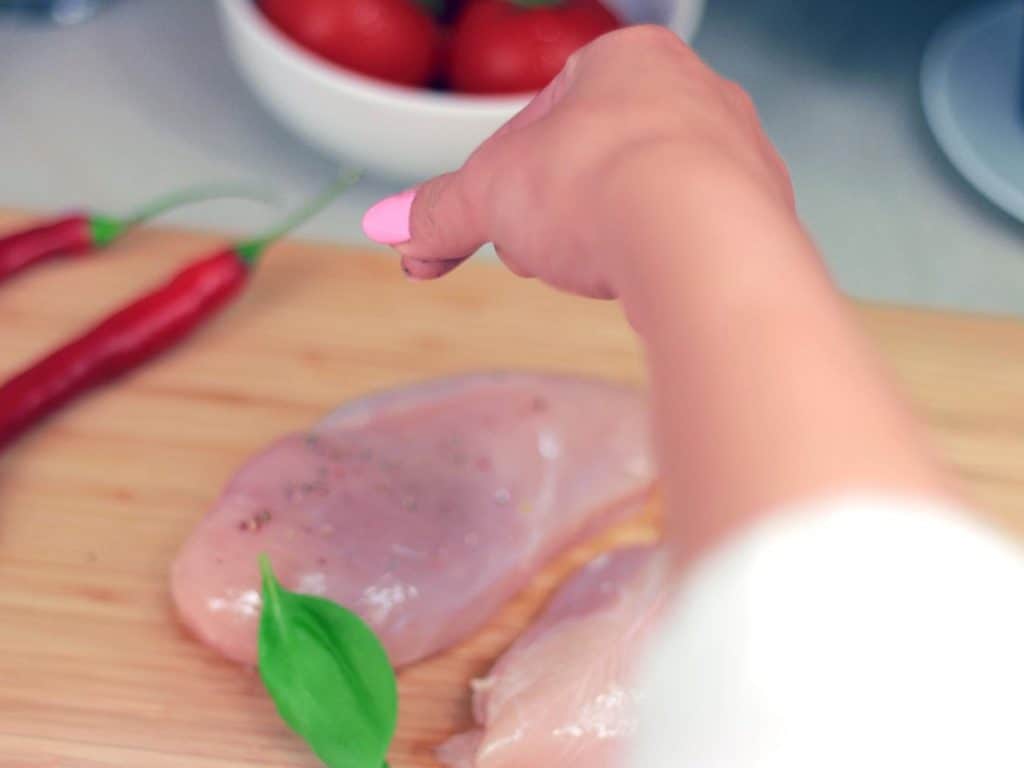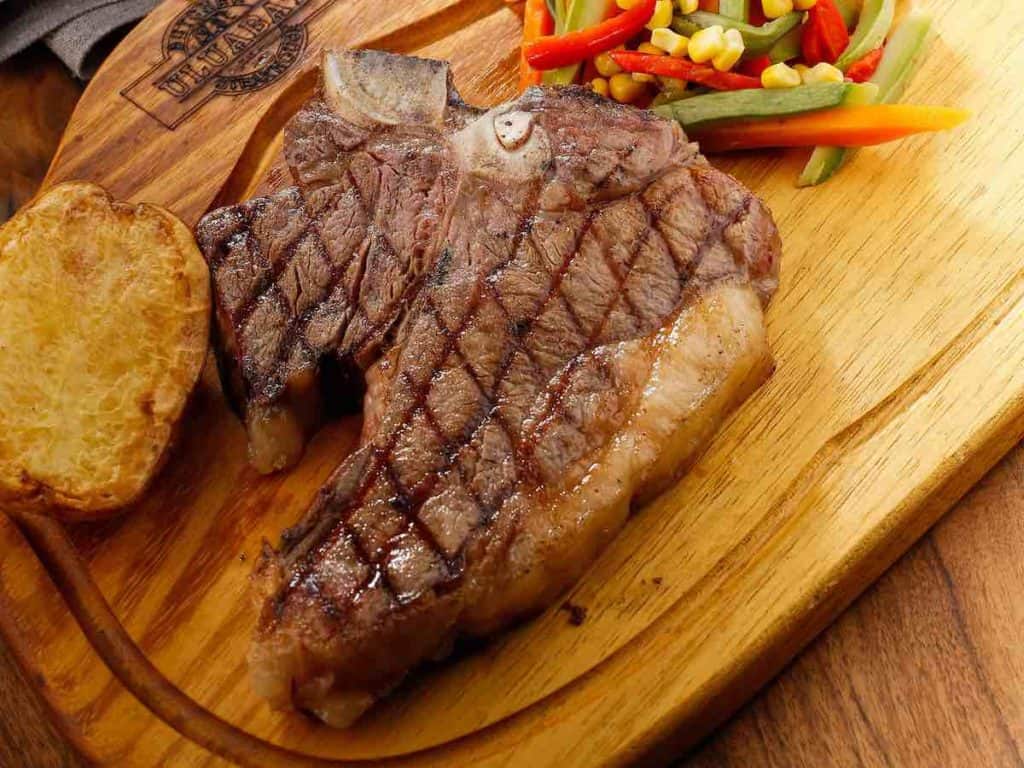Using a Cutting Board With Chicken and Raw Beef Can Be Call
And then, y'all love wowing your family unit and friends with your scrumptious chicken or beef masterpieces. Unfortunately, E. coli, salmonella and other microbes honey to thrive on these meat products, too. And they can easily spread from raw or undercooked craven and beefiness to other ingredients via your cut lath.
Using different cut boards for raw meat and fruits and vegetables is a smart and health-promoting move. But you might exist wondering if you besides have to employ different cut boards for raw chicken and raw beef.
The aforementioned cut board can be used for raw chicken and raw beef. Cross-contamination isn't a big issue since both chicken and beef will be cooked anyway, which volition kill microbes. However, the same cut board should not be used for ingredients that will non exist cooked, like fruits and vegetables.
Before you ready raw chicken or raw beefiness, keep reading.
We will talk about using cutting boards properly, especially when ingredients that could exist contaminated with bacteria are involved.
Past the stop of this article, you lot will become a pro in using cutting boards the right manner, thus keeping you and the ones you care most from ending up with food poisoning after enjoying a mouthwatering dish.

How Many Cutting Boards Should Yous Have?
When it comes to safe and good for you food training, in that location should be at to the lowest degree 2 cutting boards around. One is for raw chicken, beef and other meat products. The other is for fruit and vegetables and other ingredients that can be eaten without cooking or exposing them to high temperatures beforehand.
There are many ingredients to slice, chop, dice and mince. Alas, yous can only ain as many cut boards.
If money or kitchen space is an issue, consider having at least two cutting boards handy. One is exclusive for raw meat.
Some other is peculiarly for fruits and vegetables or other ingredients that can be consumed without cooking them beforehand. This is to avoid bacteria in raw meat from contaminating the rest.
Related Commodity: Does Freezing Kill Salmonella?
When shopping for 2 different cutting boards, you have a couple of options: forest and plastic. Each type of cut board comes with its own pros and cons…
Wooden cut lath
Many seasoned and occasional chefs love wooden cutting boards because they are durable. They too keep knives sharp longer. Yet, they are porous, which makes it like shooting fish in a barrel for bacteria to grow and multiply on them. Wooden cutting boards besides dry at a slower footstep, which can contribute to microbial growth.
Plastic cut lath
A lot of people adopt plastic cutting boards because they are easier to clean and sanitize than their wooden counterparts. They can as well come in so many different shapes, sizes and colors. Even so, they tin can irksome knives easily. Plastic cut boards are besides decumbent to having grooves, which tin can harbor bacteria.
Willing to ain multiple cutting boards for different purposes? There's a wonderful suggestion for that. Have the budget or space for but one cutting board? There's a workaround.
And this is why you lot should continue reading to become a cutting lath expert!
Using Color-Coded Cutting Boards at Home
If preventing cross-contamination and food poisoning is pinnacle priority, having color-coded cutting boards in the kitchen is a good thought. This is peculiarly true if different members of the family are involved with cooking. Nevertheless, information technology's a must to utilize every cutting lath for the correct purpose each time.
Most restaurant kitchens have several cutting boards, each i having a unlike color.
They are called color-coded cutting boards. In nigh instances, they are beneficial in professional kitchens where several different chefs have to handle food products.
By using a specific cutting board for a particular ingredient, the risk of customers catastrophe upwardly with nutrient poisoning can be considerably lowered.
You don't accept to be a seasoned chef merely to get your easily on colour-coded cutting boards. No matter your culinary skills, using these colorful kitchen essentials is recommended if cross-contamination is a complete no-no.
Here are the different colors of colour-coded cut boards and the meaning of each:
- Blood-red – raw meat
- Yellow – raw poultry
- Brown – raw fish and seafood
- Blueish – cooked food
- Green – fruits and vegetables
- White – dairy products
Information technology'south true that having color-coded cutting boards is a neat manner to foreclose cross-contamination in the kitchen.
However, there are likewise some cons to using them:
- Getting all of them costs more buying one cutting board.
- Having multiple cutting boards ways less available space.
- Requires remembering which cutting lath to use for which food item.
How Should You Clean and Store Cutting Boards?
Cutting boards can be kept clean and free of germs past scrubbing them with a sponge and hot soapy water. They can likewise be sanitized by cleaning them with a teaspoon of liquid chlorine bleach diluted with a gallon of water. Diluted white vinegar may be used, likewise, only only for low-cal cleaning purposes.
As established earlier, it's a practiced idea to have at least a couple of cut boards around.
But just because you take simply one cutting lath available doesn't hateful that you should quit making culinary masterpieces or compromise your wellness or that of your family and friends.
Regardless of how many cut boards you have, it's of utmost importance that you make clean them after each use. Cleaning is also important before proceeding with the side by side food preparation step that involves cutting ingredients. This is particularly truthful if you only have a unmarried cutting board effectually.

The following are the steps on how to clean a cutting board with dish soap:
- Rinse the cutting board with hot water.
- Apply dish soap — regular or antibacterial — to the cutting board.
- Scrub the cutting board using a sponge.
- Rinse the cutting board with hot water.
- Hang the cut board or permit information technology to lean on the wall to air dry out.
And at present, here are the steps on how to clean a cut board with liquid bleach:
- Mix ane teaspoon of liquid bleach (unscented) and i gallon of water.
- Apply the mixture to the cutting board using a sponge.
- Still using the sponge, scrub abroad food particles and stain.
- Allow the mixture to stay on the cutting board for ane to two minutes.
- Rinse the cutting lath with hot water.
- Hang the cutting board or permit information technology to lean on the wall to air dry out.
When air drying your cutting board, make sure that it's vertically or diagonally positioned, such equally by hanging it, placing it on a rack or leaning it against the wall. This is to keep water from pooling on the surface, which can keep your cutting board from drying properly and crusade it to harbor microbes.
By the manner, you lot can likewise employ diluted white vinegar (one function white vinegar to four parts h2o) for cleaning a cutting lath. Yet, it's not as expert as dealing with germs as dish soap and diluted bleach.
Related Article: What Is Chicken Tartare?
Needless to say, apply vinegar for light cleaning cut boards or eliminating stubborn stains or odors.
Just 1 quick tip on washing cut boards before we proceed to the next topic: always wash both sides of a cutting board fifty-fifty if you lot used only one side.
Particularly if your cutting board is out of wood, washing both sides after use can help prevent uneven drying, thus keeping your of import kitchen utensil from warping or keen. And, again, shop it upright or diagonally to make sure it dries properly before you put information technology into committee all over again.
Just Before You Cut and Slice Raw Meat
Having color-coded cutting boards is always an pick. But if saving coin and kitchen space is superlative priority, y'all can have only two cut boards — 1 for raw meat products and the other for ingredients that require no or footling cooking.
But you tin also stick to one, although you should sanitize information technology in between uses.
Related Questions
How frequently should you lot replace cut boards?
It'south recommended to replace cutting boards at least once a year. In some instances, cut boards have to be replaced iii to 4 times a yr if they are used very often. Every bit a general rule of thumb, yous should supplant cutting boards if they have a lot of grooves or are already warped.
Can you place cutting boards in the refrigerator?
Cutting boards can exist placed in the fridge. They tin create additional surfaces when placed on tiptop items with the aforementioned pinnacle. However, cutting boards out of woods may quickly crevice or warp due to the constant changes in temperature when taking them in and out of the fridge.
Read Too: Tin can You Eat Tuna Steak Raw?
Source: https://foodwine.com/cutting-board-chicken-beef/